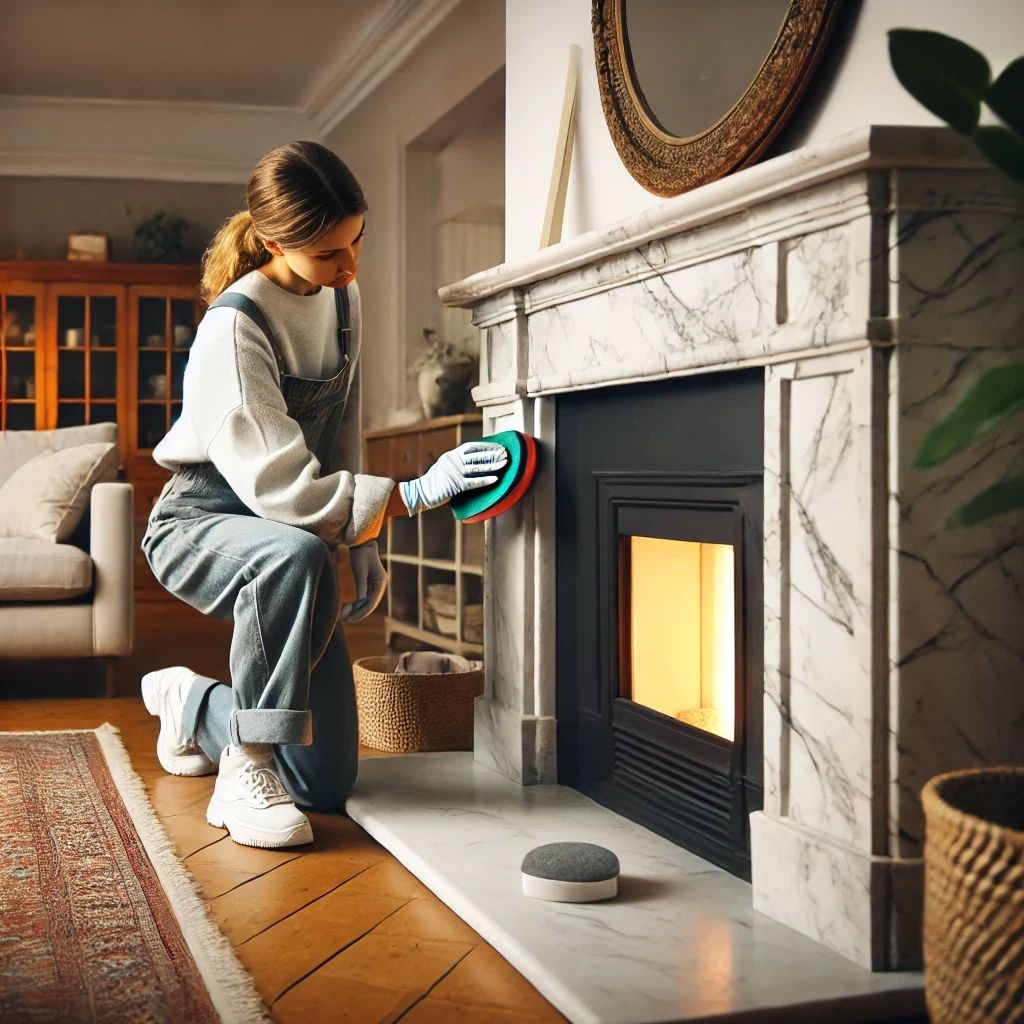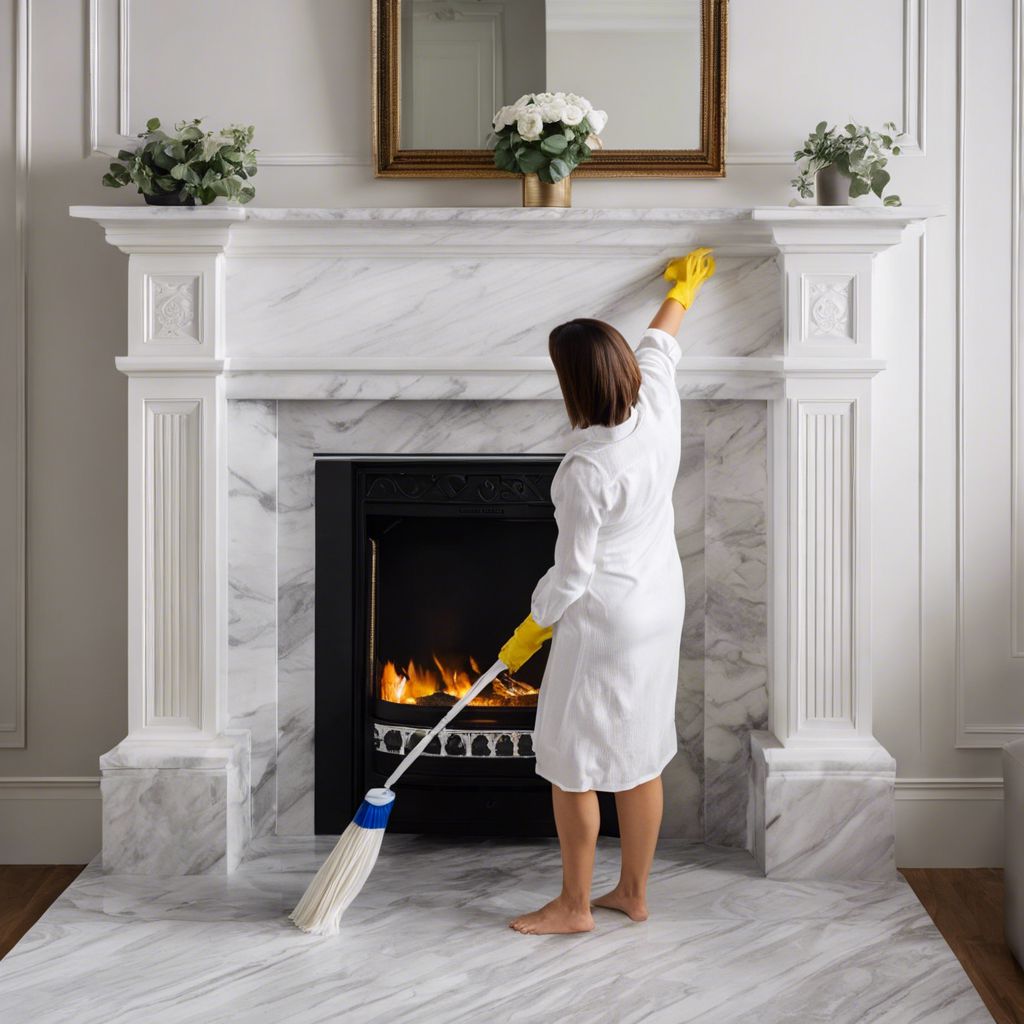
Key Takeaways
- Refinishing a marble fireplace involves cleaning, sanding, polishing, and sealing the stone.
- You can identify the need for refinishing by looking for dullness, scratches, or stains.
- You’ll need non-acidic cleaners, fine-grit sandpaper, a polishing powder suited for marble, and a high-quality sealant.
- Follow the step-by-step guide below to ensure a successful refinishing project.
- Maintain your newly refinished marble fireplace with regular cleaning and prompt stain management.
Renew Your Marble Fireplace with Confidence
Before we dive into the nitty-gritty, let’s ensure we’re on the same page. Marble is a natural stone that’s both durable and delicate. It can withstand high temperatures, making it perfect for fireplaces, but it’s also prone to scratches and etching. That’s why refinishing is a delicate balance between restoring its shine and maintaining its integrity.
Essentials You Need to Begin
First things first, you’ll need to gather your materials. But remember, not all products are marble-friendly. You’ll want to avoid anything acidic or overly abrasive. Here’s what you should have on hand:
- Non-acidic, gentle cleaner
- Fine-grit sandpaper (200 to 3000 grit)
- Marble polishing powder
- High-quality marble sealant
- Soft cloths and a sponge
- Marble repair kit (if there are chips or cracks)
Signs Your Marble Fireplace Needs Refinishing
How do you know if it’s time to refinish your marble fireplace? Look for these tell-tale signs:
- The surface appears dull and lacks its original shine.
- There are visible scratches or etch marks from wear and tear.
- Stains are present from spills or soot that won’t come out with regular cleaning.
If you’ve noticed any of these issues, it’s time to roll up your sleeves and breathe new life into your marble fireplace.
Gathering Your Materials
Let’s get into what you’ll need in more detail. The right materials will make the difference between a so-so outcome and a stunning finish.
Selecting the Right Cleaning Agents
When it comes to cleaning marble, gentleness is key. Opt for a pH-neutral cleaner specifically designed for stone. Harsh chemicals can damage the surface, so steer clear of vinegar or general-purpose cleaners.
Choosing Sandpaper for Marble
Sanding marble might sound daunting, but it’s all about the grit. Start with a lower grit to smooth out any roughness or remove stains and work your way up to a finer grit for a smooth finish.
- 200 to 400 grit for initial sanding
- 800 to 1500 grit for smoothing the surface
- 2000 to 3000 grit for the final polish
And remember, always sand wet to keep the dust levels down and to protect your marble.
Which Polishing Powder Works Best
Not all polishing powders are created equal. You’ll want a powder that’s designed for marble to achieve that high-gloss finish. Tin oxide is a popular choice among professionals, but there are many marble-specific options available.
Finding a High-Quality Sealant
The final step in refinishing your marble fireplace is sealing it to protect against future stains and damage. Look for a sealant that’s made for marble and is labeled as penetrating to ensure it soaks into the stone and offers lasting protection.

Refinishing Marble Fireplace Steps
Now that you’ve got your materials, let’s walk through the steps. Take your time with each stage to ensure the best results.
Step 1: Preparation: Remove Non-Marble Materials
Before you start, remove any items from your fireplace, including grates, andirons, or decorative elements. Tape off any areas you don’t want to sand or seal, such as the walls or flooring around the fireplace.
Step 2: Cleaning the Fireplace
Grab a mild detergent or a special stone cleaner – think of it as the marble’s favorite shampoo. Now, take a good look at your marble. See any dirt, dust, or grime? It’s time to bid them farewell! Gently wipe down the surface. Remember, marble can be sensitive, so be gentle to avoid any scratches. Think of it as a delicate dance, where every move is soft and caring.
Step 3: Assessment and Repair
After you’ve prepped the area, take a good look at the marble. Are there any chips or cracks? If so, now’s the time to repair them. A marble repair kit usually comes with everything you need to fill in any imperfections. Follow the instructions carefully, and let the repair dry completely before moving on to the next step.
Step 4: Sanding the Marble
Sanding is what will get rid of the superficial scratches and stains. It’s important to do this wet, so keep a spray bottle handy to mist the surface as you work. Begin with the lower grit sandpaper and move in smooth, circular motions. Rinse the marble with water and a sponge periodically to remove any debris.
Ensuring Even Sanding
To avoid uneven spots, sand the entire surface systematically. Work in sections and keep track of where you’ve been. Consistency is key here. Don’t press too hard – let the sandpaper do its job. As the marble begins to look more uniform, switch to a higher grit sandpaper to refine the smoothness.
Avoiding Common Sanding Mistakes
One of the biggest mistakes is rushing the sanding process. Slow and steady wins the race. Also, never sand dry, as it can cause scratches and dust that’s harmful to breathe. Always use a gentle touch and remember, patience pays off.
Step 5: Polishing to Perfection
Once you’re satisfied with the sanding, it’s time to polish. Sprinkle a small amount of polishing powder onto the marble. Using a slightly damp cloth, work the powder into the marble with circular motions. You’ll start to see the shine come back to the stone.
Using Polishing Powder
Choose a polishing powder suitable for marble, and don’t be afraid to use a little elbow grease. You’ll want to cover the entire surface evenly, reapplying the powder as needed. It’s this step that really brings back the marble’s radiance.
Buffing Techniques for a Shiny Finish
After polishing, buff the marble with a clean, dry cloth. This will remove any residual powder and enhance the shine. Again, work in a circular motion and take your time. You’ll know you’re done when you have a smooth, reflective surface. Remember, the goal is to achieve a mirror-like finish.
Step 6: Sealing for Protection and Sheen
The final step is sealing the marble. This is essential as it protects the stone from stains and damage. Apply the sealant according to the manufacturer’s directions, usually with a soft cloth. Cover the marble evenly, ensuring no spots are missed.
Applying the Sealant Evenly
Work in small sections and use a soft, lint-free cloth to apply the sealant. Spread it thinly and evenly, and watch for any pooling. The sealant should penetrate the marble, not sit on top of it. After you’ve applied it, give it time to soak in before wiping off any excess.
Allowing Proper Drying Time
Patience is just as important at this stage as it was during sanding and polishing. Follow the sealant’s instructions for drying time – typically, it’s a few hours. Don’t rush this part; you want the sealant to cure properly to provide the best protection.

Maintaining Your Refinished Fireplace
Now that your marble fireplace is looking like new, let’s keep it that way. Maintenance is simple but important.
Regular Cleaning Tips
For regular cleaning, use a soft cloth and a pH-neutral cleaner. Wipe up spills as soon as they happen to prevent stains. And never use abrasive cleaners or scrubbers – they can damage the sealant and the marble beneath.
Preventing Future Stains and Scratches
Be mindful of what you place on the mantel, and use coasters or felt pads under decorative items. If you use your fireplace regularly, have a screen in place to protect the marble from flying sparks. And remember, the sealant isn’t permanent – plan to reapply it every couple of years, or sooner if you notice water isn’t beading up on the surface anymore.
There you have it – a step-by-step guide to refinishing your marble fireplace. With a little bit of time and effort, you can restore the natural beauty of your marble and make your fireplace a focal point in your home once again.
Accessorizing Your Fireplace
Accessorizing your marble fireplace is like putting the cherry on top of a sundae. It’s the final touch that brings everything together. But with marble, you want to be mindful of the accessories you choose. They should complement, not detract from, the marble’s natural beauty.
Choosing Accessories in Harmony with Marble
When selecting accessories for your marble fireplace, consider the following:
- Material: Opt for materials that complement marble, like brass, glass, or wood.
- Color: Choose colors that echo the marble’s veining or contrast beautifully against it.
- Scale: Make sure the size of your accessories is in proportion to the fireplace.
By keeping these factors in mind, you’ll enhance the elegance of your marble fireplace rather than compete with it.

Frequently Asked Questions (FAQ)
How Often Should You Refinish Your Marble Fireplace?
It usually depends on use and exposure, but as a rule of thumb, consider refinishing your marble fireplace every few years to maintain its shine. If you notice scratches or dullness, it might be time for a touch-up.
Can All Marble Fireplaces Be DIY Refinished?
Most marble fireplaces can be refinished by a diligent homeowner. However, if your fireplace has extensive damage or if you’re not comfortable with the process, it’s best to call in a professional.
Is it Necessary to Seal Marble Fireplaces?
Absolutely. Sealing is essential to protect your marble from stains and damage. It’s the final step in the refinishing process and should not be skipped.
What Are the Risks of DIY Refinishing Marble?
The biggest risk is using the wrong products or techniques, which can damage the marble. That’s why it’s important to follow the steps outlined here and use products designed for marble.
How Do You Know Which Marble Sealer to Use?
Look for a sealer that is specifically labeled for use on marble. It should be a penetrating sealer, not a topical one, to ensure it soaks into the stone and provides the best protection.
- Choose a sealer based on the finish you want (matte or glossy).
- Check the label for compatibility with marble.
- Read reviews and see what other DIYers have used successfully.
Refinishing your marble fireplace can seem daunting, but with the right tools, a little bit of knowledge, and some elbow grease, you can achieve professional-looking results. Just remember to take your time, follow the steps carefully, and don’t be afraid to call in a professional if the project becomes too much to handle. With your newly refinished marble fireplace, you’ll have a stunning centerpiece that not only adds value to your home but also brings you joy every time you light a fire.





Leave a Reply